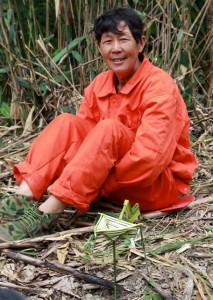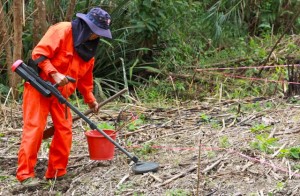Project Sekong 2012: Meet our team. Youa Xiong Vue, deminer and ethnic Hmong.

Youa Xiong Vue is a resourceful problem solver. He often fills his spare time making tools from objects he finds in the scrap bucket. Here, he displays children's toys woven from reeds.
Report 35
Youa Xiong Vue is the elder of our two Hmong deminers. He’s fifty years old and is addressed by everyone on the team as “Paw Tou” (Uncle). I’m impressed by the dignity with which he carries himself. He’s a soft-spoken, unassuming man who asks little for himself and is quick to see to the needs of others.
Youa Xiong has a talent making use of scant resources to fashion creative solutions to problems. The other day he spotted an unusual piece of scrap metal. By the next morning he had fashioned a knife from it, somehow also finding the time to carve a hardwood handle. He has the amusing habit of pilfering the scrap pile for things that turn up in our digging — things that he works into useful objects to carry home when this project ends. A pair of forceps, of all things, turned up the other day and then quickly disappeared. I know who must have them. One day, over lunch, he entertained us by weaving children’s toys out of reeds that he found growing along a nearby stream. His hands deftly brought to life a couple of cranes; he then wove a water bowl for the birds to drink from.
Youa Xiong hasn’t worked in clearance long, I’m guessing that he has just recently made the first career move in his life, from farmer to deminer. This job may well be the first time that he has worked for wages.
Youa’s from the area around Lak Sao in Bolikomxai Province. I’ve visited Hmong villages in that area when I conducted clearance on the Nakai Plateau; I even recruited Hmong villagers from his district to cut brush for my project but, apparently, I never reached his village.

The first step in clearing a new parcel of land is to rope the area into clearance boxes. Then, the deminers run their detectors over every square inch of the box and listen for the detector to indicate the presence of metal. Every indication has to be investigated and all metal removed from the site. Bomblets, on the other hand, are never moved and must be destroyed in place.
Most people associate the Hmong in Laos with the mountaintops in Xieng Khuang or Huaphan Province but there have been Hmong in southern Laos for generations. During the Vietnam War, when General Vang Pao led the CIA-recruited Hmong forces near the Plain of Jars, the southern Hmong did not join that effort. There were even Hmong in the south, the so-called “Red Hmong,” who aligned themselves with the Pa Thet Lao. The divisions among the Hmong in those years had less to do with political philosophy than they did old rivalries among Hmong clans for leadership and the economic advantage.
Youa Xiong has two daughters in America, one in a city in California that he can’t recollect, the other in Saint Paul. Both have married Hmong-American men from the Vang clan. I told Youa Xiong that Saint Paul was an easy jaunt for me and that when I return home I’ll make a point of calling on his daughter and her family. Youa seemed pleased but cautioned me that his son-in-law, an American citizen who came to Lao to find a bride, doesn’t like his daughter to be out in public much; he prefers that she stay close to home.
I didn’t need my glasses to read between those lines. Some Hmong-American men, put off by the liberated ways of some Hmong-American women, travel to the old country to find a spouse they trust will live life according to the old ways. (Ways that… guess what?… usually favor the male!) Sadly, stories abound in Hmong communities in America of a wife in such a marriage assimilating to American culture faster than her husband. Often, anger, frustration, and domestic abuse result.
Youa Xiong and our other Hmong deminer, Chan Mai Vue present themselves as cousins, but even the Lao on our team don’t entirely grasp what that means. Every Hmong in the world who is a member of the Vue clan views every other Vue in the world as a brother, sister or cousin. For that reason no two Vue’s can marry one another. The prospective bride and groom might be born continents apart, but they are cousins and their marriage would be an incestuous union, an anathema among the Hmong worldwide. (The same incest prohibition exists within all of the major Hmong clans).
There isn’t a single member of this year’s crew that I wouldn’t enlist for next year’s project but, should future work take me to northern Laos or other region heavily populated with Hmong, Youa will be my first recruit.
